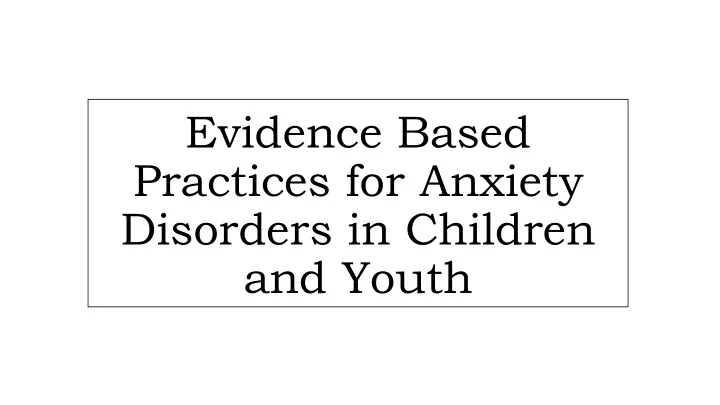

Evidence Based Practices for Anxiety Disorders in Children and Youth
Why This Topic? • Most children, youth and adults that we saw at Hillside experienced some sort of anxiety related disorder. • Not surprisingly given the rate at which we experienced clients with an anxiety disorder…Anxiety Disorders are one of the most common wide spread and pervasive disorders amongst the mental health field • If you think of the flu as one of the most common illnesses that used to have a deadly affect on the population, anxiety disorders are like such, but for mental illness.
The Affects of Anxiety Disorders • On a large scale Anxiety Disorders cost the U.S. more money than any of the affective mood disorders and schizophrenia combined. • It affects people mentally, physically, socially and occupationally. • In regards to children and youth it is the brain’s gateway “drug” to other mental illnesses. • Anxiety disorders gone untreated in childhood can lead to substance abuse, depression, recurrent suicidal ideation and hospitalization. • In fact people with anxiety disorders are 8 times more likely to be hospitalized than those without one.
The Silent Danger of Anxiety Disorders • Unlike external disorders like ADHD, or Conduct disorders, anxiety is primarily a internal disorder. • Meaning the symptoms may often go unnoticed. Children do not often act out, or express their discomfort outside of their family members. • Therefore at school children with anxiety disorders often go unnoticed, while children with external disorders often receive the allocated Mental Health resources available. • Children with anxiety disorders often say things like “I don’t feel good,” “I’m scared”, “I have a stomach ache”, “I don’t want to go to school”
Parenting Anxious Children • While parents of children with external disorders may recognize the symptoms of hyperactivity, or misbehavior, parents of children with anxiety disorders may not completely understand their child is experiencing anxiety. • Furthermore, often well intended parents of anxious children do more harm than good. • Parents may want to protect their children from their anxious distress and may help them avoid facing situations that trigger anxiety, which in the long term does not help the child to work through their anxious feelings.
So Why Evidence Based Practices? • In the past, the medical field was not held to a scientific standard for much of their medical practices. • Things like drilling holes in skulls were used as part of a solution when all else failed to helped patients with epilepsy and mental illness. • (See article) • As the medical field began to receive more funding they were called into accountability for the work they did thus creating “evidence based practices” in science.
Psychology’s Accountability • In the past the medical field primarily focused on a biological model in regards to science and disease control. • However, while the Western world has improved greatly in the area of diseases, vaccines and biological medicine, it still has one of the highest early death rates compared to other countries. • The medical field recognizes that much of the disease and illness we see today are based on behavioral decisions and mental illness rather than biological causes.
Psychology’s Accountability • This has now led to a focus of funding and collaboration between the medical field and psychology field. • Furthermore it has led to the healthcare desiring “evidence based practices” for the field of psychology and greater accountability as well. • The goal of “evidence based practices” is to combine the most recent accurate scientific research with cultural considerations and a case formulation for the client.
Evidence Based Practices & Anxiety Disorders • Sadly, most youth with anxiety disorders continue to receive services, (if they receive them at all) that lack scientific evidence and efficacy. • This means children that are treated often experience relapse, or may go away from their therapeutic experience discouraged and hopeless as they do not receive appropriate care and remission from the symptoms of anxiety. • Again this can lead to a host of other long term mental illnesses and developmental concerns, lack of healthy peer relationships, depression, substance abuse, suicidal ideation, occupational disability, etc.
Evidence Based Practices for Anxiety Disorders in Children & Youth • So what are the Evidence Based Practices for children & youth with anxiety disorders? • According to current research, Selective Serotonin Reuptake Inhibitors (SSRIs) and Cognitive Behavior Therapy combined are considered the most effective treatments for Anxiety Disorders. • The Anxiety Disorders that work well with these treatments are: Social Anxiety Disorder, General Anxiety Disorder, Specific Phobia, Separation Anxiety Disorder and Obsessive Compulsive Disorder
Now What? • Although there is a lot of information available concerning research on anxiety disorders, not a lot of therapists utilize the research available. • The reasons for the lack of utilizing evidence based practices is wide spread: discomfort with cognitive behavior therapy, lack of proper dissemination of information, lack of time to study a new model or theory, and just lack of knowledge of the information available. • As a result I created a manual to help entry level therapists utilize the best evidence based practice available, focusing on children.
The Manual • The manual focuses on: • Providing scientific reasons why therapists should utilize CBT & SSRI’s to help children and youth dealing with anxiety disorders • It simplifies the research and gives them quick insight into topics like -What are anxiety disorders -Why do people experience them -What are Evidence Based Practices for treating anxiety disorders -Developmental considerations when treating children with anxiety -Commonly prescribed medications for anxiety -What is CBT -Child friendly exercises that hit on the basic components of CBT - Parent sheets and homework explaining what took place in the child’s session and concepts being focused on in therapy.
Recommend
More recommend